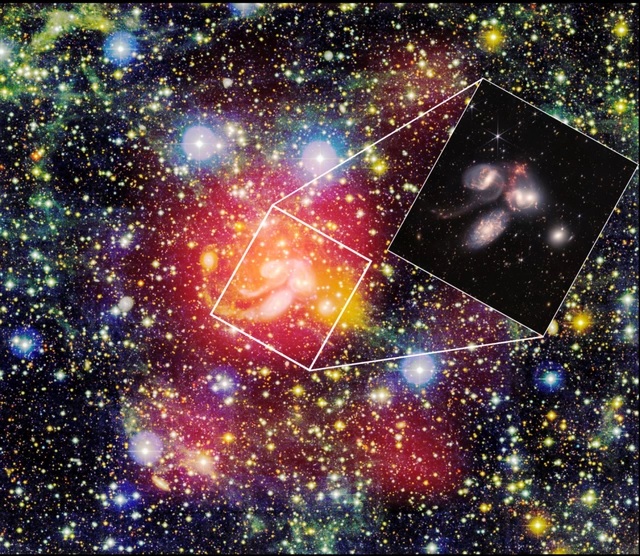
The "China Sky Eye," also known as the Five-hundred-meter Aperture Spherical Radio Telescope, has spotted a huge atomic gas structure in the vicinity of a galaxy group. [Photo/National Astronomical Observatories]
China's ultra-powerful telescope has discovered the largest atomic cloud in the universe to date, a finding that could help scientists investigate and understand the origins of galaxies, according to a study published in the journal Nature on Wednesday.
The cloud is made up of hydrogen atoms, the most abundant element in the universe.
It measures about 2 million light-years across and is about 20 times larger than our Milky Way galaxy. One light-year is about 9.5 trillion kilometers.
An international team led by Chinese scientists found the cloud by pointing the Five-hundred-meter Aperture Spherical radio Telescope in southwestern China's Guizhou province in the direction of a galaxy group called Stephan's Quintet, which was discovered in 1877 and about 290 million light-years away.
Xu Cong, a researcher from the National Astronomical Observatories of the Chinese Academy of Sciences, said stars in the universe are born from the accumulation of clouds of atomic gases, and a galaxy can contain many stars with numbers ranging from millions to trillions.
Xu said FAST's unparalleled sensitivity can detect the extremely faint signatures from hydrogen atoms in distant galaxies, thus opening a new window of opportunity to research the origins of celestial objects.
Early this year, scientists announced they had discovered a massive filament of hydrogen gas in the Milky Way galaxy.
The atomic cloud, later named Maggie, is one of the biggest structures in our home galaxy, coming in at 3,900 light-years long and 130 light-years wide.
The atomic cloud discovered by FAST is not only unique in its massive size, but its location is unusual as it is relatively far from the center of Stephan's Quintet.
Most hydrogen atoms are typically found inside or near a galaxy as they aggregate under gravity to eventually form stars.
The massive cloud may have formed during the early days of the Stephan's Quintet, and has probably existed for around a billion years, Xu said.
The study notes that other massive gas structures could be hiding in the universe and can only be seen with extremely powerful radio telescopes.
Xi Jinping's report to the 20th Communist Party of China National Congress stated that China has accelerated efforts to build self-reliance and strength in science and technology and has grown stronger in basic research and original innovation.
Manned spaceflight, lunar and Martian exploration, deep sea and deep earth probes, supercomputers, satellite navigation, quantum information, nuclear power technology, aerospace manufacturing and biomedicine are some of the fields that China has witnessed major successes in over the years.
Astronomy is another frontier science that has seen consistent discoveries by Chinese scientists thanks to the advancement in the nation's major scientific instruments, including the Five-hundred-meter Aperture Spherical radio Telescope and the Large High Altitude Air Shower Observatory.